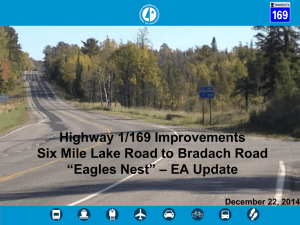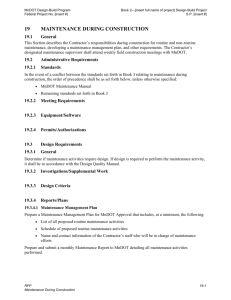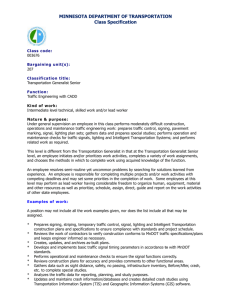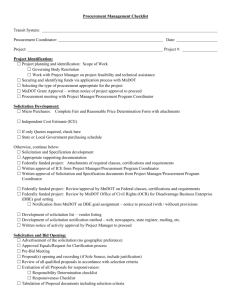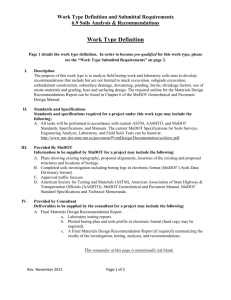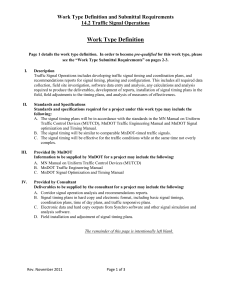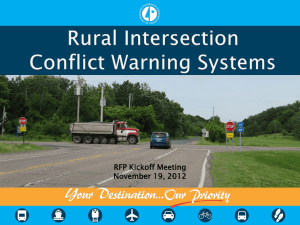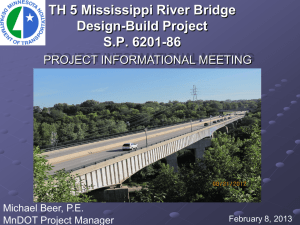Section 2 Project Management - Minnesota Department of
advertisement
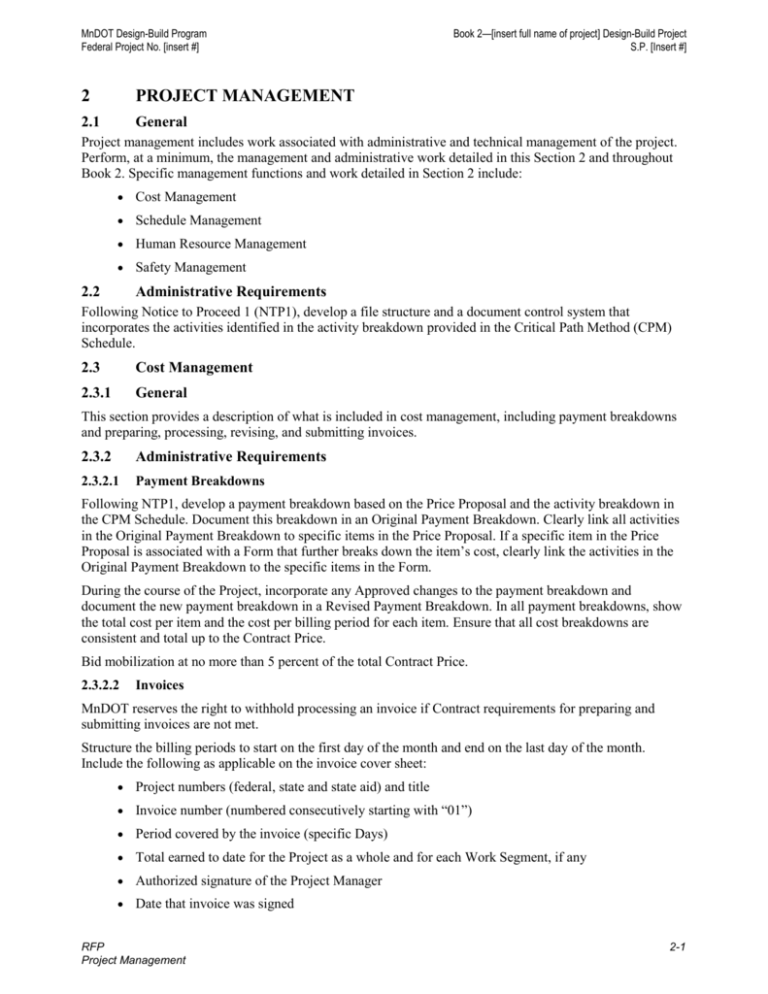
MnDOT Design-Build Program Federal Project No. [insert #] 2 PROJECT MANAGEMENT 2.1 General Book 2—[insert full name of project] Design-Build Project S.P. [Insert #] Project management includes work associated with administrative and technical management of the project. Perform, at a minimum, the management and administrative work detailed in this Section 2 and throughout Book 2. Specific management functions and work detailed in Section 2 include: Cost Management Schedule Management Human Resource Management Safety Management 2.2 Administrative Requirements Following Notice to Proceed 1 (NTP1), develop a file structure and a document control system that incorporates the activities identified in the activity breakdown provided in the Critical Path Method (CPM) Schedule. 2.3 Cost Management 2.3.1 General This section provides a description of what is included in cost management, including payment breakdowns and preparing, processing, revising, and submitting invoices. 2.3.2 Administrative Requirements 2.3.2.1 Payment Breakdowns Following NTP1, develop a payment breakdown based on the Price Proposal and the activity breakdown in the CPM Schedule. Document this breakdown in an Original Payment Breakdown. Clearly link all activities in the Original Payment Breakdown to specific items in the Price Proposal. If a specific item in the Price Proposal is associated with a Form that further breaks down the item’s cost, clearly link the activities in the Original Payment Breakdown to the specific items in the Form. During the course of the Project, incorporate any Approved changes to the payment breakdown and document the new payment breakdown in a Revised Payment Breakdown. In all payment breakdowns, show the total cost per item and the cost per billing period for each item. Ensure that all cost breakdowns are consistent and total up to the Contract Price. Bid mobilization at no more than 5 percent of the total Contract Price. 2.3.2.2 Invoices MnDOT reserves the right to withhold processing an invoice if Contract requirements for preparing and submitting invoices are not met. Structure the billing periods to start on the first day of the month and end on the last day of the month. Include the following as applicable on the invoice cover sheet: Project numbers (federal, state and state aid) and title Invoice number (numbered consecutively starting with “01”) Period covered by the invoice (specific Days) Total earned to date for the Project as a whole and for each Work Segment, if any Authorized signature of the Project Manager Date that invoice was signed RFP Project Management 2-1 MnDOT Design-Build Program Federal Project No. [insert #] Book 2—[insert full name of project] Design-Build Project S.P. [Insert #] On a monthly basis, at a minimum, meet with MnDOT to review the following prior to submitting invoices: Activity percent complete, which reflects physical percent complete estimated by field personnel, relating to a resource and cost loaded schedule activity Incorporation of approved Change Orders as individual activities with proper title, coding, associated logic, duration, and cost/resource loading Code by Change Order number Verification of any unit price items Status of outstanding Nonconforming Work and Warranties Backup documentation for cost reimbursable procurement and Change Order schedule activities 2.3.2.2.1 Invoice Calculations MnDOT will base payments on MnDOT’s estimate of physical percent complete of the Work, not on measured quantities, except where specifically stated in the Contract. The payment to the Contractor will be the amount shown on the Contractor’s Approved invoice less deductions made by MnDOT. The following Project Management items submitted with the Price Proposal will be paid by prorating any unpaid balances by the amount of time remaining until Substantial Completion: Contract Management (includes Cost Management and Schedule Management) Quality Management Human Resources Management Safety Management Public Information Management Environmental Management Payment for mobilization will be paid according to the following provisions: 25 percent will be paid at NTP1. 50 percent will be paid when 10 percent of the original Contract amount has been earned. Earned value does not include the costs of bonds, insurance, and prior mobilization payments. 25 percent will be paid when 25 percent of the original Contract amount has been earned. Earned value does not include the costs of bonds, insurance, and prior mobilization payments. Payment for insurance premiums will be paid as a pass-through of actual cost based on invoices from the insurance companies and proof of payment. Any remaining bond and insurance item balances will be paid by prorating, using the amount of time remaining until Substantial Completion. MnDOT will base payments for design on estimated percentage complete for each Release for Construction (RFC) package, with the following limitations: A maximum of 95 percent will be paid when RFC Documents have been issued. A maximum of 100 percent will be paid when all As-Built Documents have been Accepted. 2.3.2.3 Progress Reports Provide a monthly progress report that summarizes the information identified below and the monthly reports required in other Book 2 Sections. Provide the progress report in an executive summary format. Include the following in a monthly progress report: Summary of work performed during the previous month, including digital color photographs of the Project progress RFP Project Management 2-2 MnDOT Design-Build Program Federal Project No. [insert #] Book 2—[insert full name of project] Design-Build Project S.P. [Insert #] Safety Summary of Project accidents (frequency and severity) and corrective actions taken Updates to emergency services access points to the Project Site Updates on safety training provided Labor compliance Total monthly labor hours for construction/maintenance and non-construction personnel by classification of management, engineering, and other technical personnel used on the Project Disadvantaged Business Enterprise (DBE) progress and Project updates Equal Employment Opportunity (EEO) progress and Project updates Update on labor compliance unresolved issues Quality updates Summary of quality audits and quality control processes performed Listing on non-conformances and resolutions Summary of Quality Manual updates Public information updates Summary of public input received and responses Summary of media contacts Summary of complaints and resolution Environmental compliance Summary and copies of environmental monitoring reports Summary of non-compliance issues and resolution Summary of agency inspections Utilities Status of Private Utility work performed and required Status of Public Utility work performed and required Geotechnical Summary of vibration and settlement monitoring activities and issues Copies of vibration monitoring reports Copies of settlement monitoring reports Maintenance of traffic Summary of traffic switches and a look ahead to future traffic switches Summary of known traffic incidents within the work zone Visual quality Summary of visual quality activities Summary of recommendations and decisions RFP Project Management 2-3 MnDOT Design-Build Program Federal Project No. [insert #] Book 2—[insert full name of project] Design-Build Project S.P. [Insert #] Change orders Summary of outstanding change orders Summary of executed change orders 2.3.3 Deliverables 2.3.3.1 Invoices Include with the invoice an electronic copy of the billing spreadsheet and an updated schedule in an electronic medium compatible with MnDOT’s software. 2.3.3.2 Original Payment Breakdown Submit an Original Payment Breakdown to MnDOT for Acceptance as a condition of NTP2. MnDOT will respond within twenty Working Days of receipt of the Original Payment Breakdown. 2.3.3.3 Revised Payment Breakdown Submit the Revised Payment Breakdown to MnDOT for Acceptance of any change to the Payment Breakdown. MnDOT will respond within twenty Working Days of receipt of the Revised Payment Breakdown. 2.3.3.4 Design Breakdown Report Within 30 Calendar Days of NTP1, provide a breakdown of the design hours and design costs for the Project in accordance with the following: Provide in an electronic Excel spreadsheet. List all major design activities. At a minimum, break down to a level of detail consistent with the Baseline Critical Path Method (CPM) schedule. List hours and rates per activity for each employee classification (e.g., Technicians, Senior Engineers, Project Managers, and Administration). List budgeted expenses per activity. List a combined mark-up factor for overhead and profit. Sum the design activities, hours per activity, expenses, and overhead/profit mark-up into a single Lump Sum value equal to the Design Services line item in the Price Proposal. 2.3.3.5 Monthly Progress Reports Provide two hardcopies of the Monthly Progress Report and an electronic PDF copy to MnDOT. 2.4 Schedule Management 2.4.1 General This section contains the requirements for preparing and submitting a CPM Schedule using MnDOT’s Enterprise Project Management System (EPMS) Primavera P6 software to plan and schedule all work shown in the contract documents. Complete and maintain a computerized CPM Schedule as described in MnDOT Special Provision 1803 and herein. 2.4.1.1 Importing/Exporting Schedule Files MnDOT will generally not “Import” or accept Progress Schedule files from any other computer system. However, MnDOT may consider a request to import a Baseline Progress Schedule developed by the Contractor using Primavera P6 that meets the requirements of the contract documents. Acceptance to import a P6 Schedule will be at the discretion of MnDOT on a case-by-case basis. RFP Project Management 2-4 MnDOT Design-Build Program Federal Project No. [insert #] 2.4.2 Administrative Requirements 2.4.2.1 Schedule Settings Book 2—[insert full name of project] Design-Build Project S.P. [Insert #] The following scheduling settings will govern and the schedule will be calculated in P6. Global and Enterprise Data—The schedule may not contain any global or enterprise data (i.e., calendars or activity coding). Total Float Calculations—Set Total Float to finish float = late finish-early finish. Progress Override—The schedule will be calculated utilizing Progress Override. This method assumes that once an activity is started, that Work may continue without concern for uncompleted predecessor activities. It is the responsibility of the Contractor to work in sequence. MnDOT may analyze the schedule with “Retained Logic” and require any illogical results of Progress Override to be corrected prior to the schedule’s Acceptance. Percent Complete Type—Use physical as “% complete type.” 2.4.2.2 General Requirements Closely coordinate changes to the schedule with MnDOT and obtain MnDOT’s Acceptance. If MnDOT deems that the Work is performed substantially out of sequence, the Contractor will demonstrate the impacts in accordance with the Time Impact Analysis section contained herein. Manage and work with each Subcontractor and Supplier to obtain information on activities for implementation and sequencing of the Work. Reflect Contract requirements and known limitations in the schedules. Identify any condition or Work that impacts the Contractor’s commencement of an activity as outside impacts to the Project schedule, such as Work under another contract which affects the Project. In a case where Work affects or is affected by work under another contract and the affected contracts are being performed by the same contractor, coordinate the Work to minimize impacts to both contracts’ project completion dates. 2.4.2.3 Naming Convention Use the naming convention for each version of schedules as identified in Table 1803-3 of Specification 1803. 2.4.2.3.1 Preliminary and Baseline Schedule Assign a name (Project ID in P6) starting with SP# followed by “-BL00-Rev0” to each schedule. Until MnDOT Accepts the schedule (same data date), increment the Rev# by one for each submission (e.g., the first schedule is called 0000-00-BL00-Rev0, with the next submission 0000-00-BL00-Rev1, etc.). Once the schedule is Accepted, for the next schedule (different data date) increment the BL# by one with the Rev# starting back at zero (e.g., 0000-00-BL01-Rev0), with Rev# increasing by one for each submission applicable to that data date. 2.4.2.3.2 Impact Schedule Submit Impact Schedules via a Time Impact Analysis in accordance with the Time Impact Analysis section contained herein. Assign a file name (Project ID) starting with “SP#-I001” to Impact Schedules and increase by one for every submitted Impact Schedule. 2.4.2.3.3 Revision or Recovery Schedule Assign a file name to the first Accepted Impact Schedule (new Working Schedule) starting with file name “SP#-RE00”; however, the Rev# indicates the Accepted Impact Schedule (e.g., file name 0000-00-RE00RevI001). RFP Project Management 2-5 MnDOT Design-Build Program Federal Project No. [insert #] 2.4.2.4 2.4.2.4.1 Book 2—[insert full name of project] Design-Build Project S.P. [Insert #] Notice(s) to Proceed Preliminary Schedule(s) Continually improve upon the Preliminary Schedules and show the status of work actually completed until it is Accepted as the Baseline. Submit Preliminary Schedules with data dates of the 15th and last Day of every month to MnDOT within four Calendar Days after applicable data date. 2.4.2.4.2 Baseline Schedule Do not extend the Baseline Schedule beyond any Completion Deadlines, include negative Float, nor utilize any other prohibited scheduling techniques. A total of not more than 20 percent of the Baseline Schedule activities may be Critical Activities or 30 percent Near Critical Activities, unless otherwise authorized by MnDOT. Perform no permanent Work prior to Baseline Acceptance without Approval from MnDOT. Acceptance of the Baseline Schedule by MnDOT is a condition of NTP2. The Baseline includes, at a minimum, the applicable level of detail indicated in the “Level of Detail” section contained herein, unless changes are Approved by MnDOT. Failure to include any element of required Work in the Project schedule does not relieve the Contractor from completing all Work necessary to complete the Project according to Completion Deadlines. 2.4.2.5 Schedule Updates At a minimum, submit an updated schedule monthly that accurately records the dates Work started and was completed. The schedule should be received within four Calendar Days. Closely coordinate changes to the schedule with MnDOT and obtain MnDOT’s Acceptance. If MnDOT deems Work is performed substantially out of sequence, demonstrate the impacts in accordance with the Time Impact Analysis section contained herein. Minimize the number of changes and state within the narrative of the update the reasons for any changes to the schedule. MnDOT may elect to allow the Contractor to include modifications such as adding or deleting activities or modifying activity descriptions, durations, or logic without submitting a “Time Impact Analysis” as long as, in the sole opinion of MnDOT, the modifications do not: Alter the critical path(s) or near critical path(s) Extend the scheduled Completion Deadlines or Milestone(s) compared to that shown on the current Accepted Working Schedule Disrupt the integrity or comparative relationship between the last Accepted Working Schedule Consume “unreasonable” amount of Total Float Modify budget estimates on in-progress activities Delete in-progress activities with budget estimates If, in the sole opinion of MnDOT, any proposed changes in planned Work will result in any of the above stated conditions, submit a “Time Impact Analysis” as described herein. 2.4.2.6 Acceptance of Schedule MnDOT’s review and Acceptance of schedules will not waive any Contract requirements and does not relieve the Contractor of any obligation or responsibility for submitting complete and accurate information. By review and Acceptance of the schedule, MnDOT does not endorse or otherwise certify the validity or accuracy of any part of the schedules. The responsibility for validity and accuracy of all schedules is the sole responsibility of the Contractor. Errors or omissions within schedules do not relieve the Contractor from finishing all Work within the time limit specified for completion of the Contract. If, after a schedule has been Accepted by MnDOT, and either the Contractor or MnDOT discovers that any aspect of the schedule has an error or omission, correct the schedule and indicate the effects in accordance with the “Time Impact Analysis” section contained herein. RFP Project Management 2-6 MnDOT Design-Build Program Federal Project No. [insert #] 2.4.2.6.1 Book 2—[insert full name of project] Design-Build Project S.P. [Insert #] Preliminary and Baseline Schedules MnDOT will Accept or return comments on submitted schedules within seven Calendar Days after being received. Address comments within seven Calendar Days after MnDOT returns comments. It is the Contractor’s responsibility to meet with MnDOT as often as necessary to satisfy MnDOT’s comments within said seven Calendar Days. 2.4.2.6.2 Schedule Updates Estimate physical percent complete and remaining duration of each activity for each schedule update. If the Contractor intends to invoice for items such as materials on hand, record those costs in the “actual costs” field in the expense tab, with the “expense item” called “invoice.” Incorporate all Change Orders and costs into the schedule updates and include Change Order activity in the schedule. All Change Orders must be coded in accordance with the change management section contained herein. 2.4.2.6.3 Impact Schedules MnDOT will Accept or return comments on submitted schedules within fourteen Calendar Days after being received. Address comments within seven Calendar Days after MnDOT has returned comment. It is the Contractor’s responsibility to meet with MnDOT as often as necessary to satisfy MnDOT’s comments within said seven Calendar Days. 2.4.2.7 Weekly Look-Ahead Schedule Submit weekly a detailed, forward-looking schedule for a period of at least twenty-one Calendar Days. This schedule may be a hand or computer-generated bar chart and must specifically reference the applicable CPM activity ID. This Look-Ahead Schedule must be in greater detail than the Working Schedule and define specific daily operations at each specific location to be performed during the three-week period. 2.4.2.8 Schedule Recovery Whenever the current Working Schedule indicates negative Float greater than 5 percent of the remaining Calendar Days before a contractual obligated milestone, but in no case greater than negative forty Working Days, submit a Time Impact Analysis (TIA) as described in “Time Impact Analysis” section herein within seven Calendar Days. Recover the negative Float regardless of fault of either party for past delays in the Impact Schedule. The requirement to recover negative Float regardless of fault is not a directive by MnDOT to accelerate the Work but rather a directive to provide a proposal. Any cure involving acceleration, at a cost to MnDOT, will be directed in writing from MnDOT prior to any execution of acceleration thereof. 2.4.2.9 Change Management Provide MnDOT with the schedule activity(s) that was affected and document it in the Change Order. Incorporate all Change Orders into the schedule. Provide each Change Order with its own activity ID and assign to a cost account “SP#-CO.” Additionally, assign each Change Order to the activity code “DETL” with the value of the DETL code equal to the CO#. 2.4.2.10 Time Impact Analysis Determine the effect of an impact as soon as possible, and do not wait to analyze the effects of an impact; this may require estimates of the duration of the impact. Submit a TIA at any time the Contractor is unsure if any one event, or accumulation of events, impacts a Completion Deadline. Failure to submit a TIA addressing the impact will be considered prima facie evidence that MnDOT was not afforded the opportunity to mitigate the impact. At any time, MnDOT may require the Contractor to demonstrate the impacts of any change, or proposed change, to the schedule via a TIA and require the Contractor to submit the TIA within seven Calendar Days of receiving the request, even if the Contractor believes that there is no impact to the schedule. Include a statement in the TIA that there is “no effect to the schedule” OR, include the following in the TIA: RFP Project Management 2-7 MnDOT Design-Build Program Federal Project No. [insert #] Book 2—[insert full name of project] Design-Build Project S.P. [Insert #] An Impact Schedule Any associated cost burden or savings A narrative report developed specifically to demonstrate effects of deviations from the current Working Schedule to include: A detailed factual statement of the impact, and its cause, providing all necessary dates, locations, and items of Work affected and included in each impact The date or dates on which actions resulting in the impact occurred or conditions resulting in the impact became evident Identification and copies of all pertinent documents relating to such impact Basis for entitlement and identification of the provisions of the Contract which support the impact All, if any, concurrent Contractor-caused delays during the time frame of the impact Affected activity ID(s) of the schedule for which the impact is to be presented and how they were affected Any additional information requested by MnDOT MnDOT may Accept the Impact Schedule as the new Working Schedule while parties determine associated cost burden or savings. All accepted Impact Schedules become the next Working Schedule and with the Impact Schedules file name referenced in the revision field. 2.4.2.11 Float Suppression/Sequestered Float/Use of Float Do not engage in Float suppression manipulations that have the net effect of sequestering Float time. It is expressly agreed and understood that the Contractor is not entitled to any compensation or damages on account of delays which could have been avoided by revising activity time or logic used to sequester Float and will exclude the Contractor’s right to recover any delay damages or compensation. Lags/Leads are subject to the consent of MnDOT. Remove any Lags/Leads and replace with an activity identifying the Lag/Lead upon request of MnDOT, regardless of prior Acceptance on previous schedules. The Contractor acknowledges that all Float is a shared commodity available to the Project and is not for the exclusive benefit of any party, but is an expiring resource available to accommodate changes in the Work, however originated. Contract time extensions for Contract performance will be granted only to the extent that delays or disruptions to affected work paths exceed total Float along those paths of the current Working Schedule in effect at the time of delay or disruption. It is understood that identified contingencies, as described in the “Calendar and Identified Contingency” section, become available Total Float as time elapses and the contingency was not used. 2.4.2.12 Early Completion Should the Contractor intend to complete, or actually complete the Work, or any portion thereof, earlier than any Completion Deadline, it is understood that Project benefits from the increase in shared Total Float. The Contractor agrees that delays are only based on impacts to the Completion Deadlines, not the Planned Early Finish date of the Schedule. Completion Deadlines can only be changed by an executed Change Order. 2.4.2.13 Calendars and Identified Contingency The duration of each activity includes the necessary Work Days to actually complete the Work defined by the activity; contingency is not to be built into the durations. Each activity is assigned the appropriate calendar as it relates to each major item of Work. Each calendar, with the exception of the calendar utilized for tracking Calendar Days, includes contingent non-Work Days; with Saturday or Sunday not allowed to be shown as a contingent non-Work Day. Estimate sufficient weather contingency and include a minimum of 15 percent weather contingency for each major item of Work affected by weather. Submit a statement indicating duration (in hours) of the Contractor’s normal Work Day as it relates to the work week (e.g., M-F [10 hrs] RFP Project Management 2-8 MnDOT Design-Build Program Federal Project No. [insert #] Book 2—[insert full name of project] Design-Build Project S.P. [Insert #] and Sat [6 hrs] for each calendar). Contingency will be the amount of indicated non-Work Days compared to this statement. If the Contractor does not submit this statement, it will be considered prima facie evidence that the Contractor did not account for sufficient weather impacts. 2.4.2.14 Non-Compliance The Contractor's refusal, failure, or neglect to diligently pursue timely Acceptance of any schedule or TIA constitutes reasonable evidence that the Contractor is not prosecuting the Work, or separable part, with the diligence that will ensure its completion within the applicable Completion Deadline and constitutes sufficient basis for MnDOT to exercise one or a combination of the following options: assess a monetary deduction based on Book 1, Section 12, or withhold an amount up to 100 percent of the estimated value of work performed until the schedule is accepted. 2.4.2.15 Level of Detail Cost-load the schedule as the basis to administer the payments to the Contractor. Utilize cost accounts reflective of Price Proposal bid items and assign applicable cost-loaded activities to respective cost accounts. The costs assigned to schedule activities roll up to equal the price for each item identified in the Price Proposal and ITP Form 19. The total cost of all schedule activities equals the Contract Price. If Form 19 is part of the ITP, use the activity code of “DETL” to represent the costs indicated on those forms; the code value indicates which form number the costs represent, and the “description” represents the name of the individual costs within the respective form. The cost assigned to individual schedule activities may not artificially inflate, imbalance, or front-load the items. Substantiate an activity if MnDOT questions the definition, costs, or production rate of it. MnDOT may require questioned activities to be resource-loaded to include a reasonable estimate of either a commodity or labor hour upon which value or production is based. At a minimum, each activity: Has a unique activity description and contains a verb Is a duration of not more than twenty Working Days nor less than five Days, unless otherwise authorized by MnDOT Has at least one predecessor and one successor activity, except for Project start and finish, respectively Expresses activity durations in Days Create the Baseline Schedule with sufficient detail to accurately reflect the complexity and numerous construction operations of this Project to the satisfaction of MnDOT. The minimum level of detail required is described below Administration Schedule milestones Mobilization All submittals (design packages, shop drawings, etc.) MnDOT review periods Utility notification and relocation, by utility Material on hand (procured items) requests and payments Substantial completion Punch list Bridges RFP Project Management 2-9 MnDOT Design-Build Program Federal Project No. [insert #] Book 2—[insert full name of project] Design-Build Project S.P. [Insert #] Per Special Provision 1803 Foundations, substructure, superstructure, and decks Roadway Per Special Provision 1803 ITS devices per location 2.4.3 Deliverables 2.4.3.1 Schedule Submission 2.4.3.1.1 Gantt Chart Submission Reports Submit and include as attachments in PDF format the Schedule Gantt Chart Reports produced out of the P6 Software. Include a narrative for each schedule submittal to include and discuss: A bar chart of all activities, sorted by Early Start and indicating Longest Path in red A bar chart sorted by Early Start for each Milestone’s Critical Path A bar chart, of only activities with Total Float less than 10 Days, sorted by Early Start Upcoming and pending coordination required with MnDOT, or third parties Potential problem areas Description and reason for any changes made to the schedule and the effects the changes have on Milestones or Project Completion Date Include bar charts for each schedule submittal containing the following information: Activity ID and description Original Duration Early Start, Late Start, and Late Finish. Total Float Include a title block and a timeline on each page. At a minimum, the title block includes file name, revision, start date, finish date, data date, and run date. 2.4.3.2 Preliminary Schedule Submit a Preliminary Schedule to MnDOT for Acceptance. Acceptance of the Preliminary Schedule is a condition of NTP1. 2.4.3.3 Baseline Schedule Within twenty-one Calendar Days following NTP1, submit a Baseline Schedule to MnDOT for Acceptance. 2.4.3.4 Schedule Updates Submit an updated schedule monthly with invoices that accurately records the dates Work is started and completed. Submit the schedule as within four Calendar Days. 2.4.3.5 Time Impact Analysis Submit a TIA in accordance with the Time Impact Analysis section contained herein. 2.4.3.6 Weekly Look-Ahead Schedule Submit weekly, a detailed, forward-looking period of at least twenty-one Calendar Days. This schedule may be a hand- or computer-generated bar chart, but specifically references the applicable CPM activity ID. RFP Project Management 2-10 MnDOT Design-Build Program Federal Project No. [insert #] 2.5 Human Resource Management 2.5.1 General Book 2—[insert full name of project] Design-Build Project S.P. [Insert #] This Section describes the requirements of human resource management, including identifying Key Personnel, co-location, facilities, and equipment requirements. 2.5.2 Administrative Requirements 2.5.2.1 General Ensure all personnel performing Work on the Project have the experience, skill, and knowledge to perform the Work assigned to them. Ensure all personnel performing Work on the Project also have appropriate required professional licenses and certifications. 2.5.2.2 2.5.2.2.1 Key Personnel General Key Personnel for the Project include the following: Design Build Project Manager Design Build Construction Manager Design Manager Design Lead Engineer—Structures Design Lead Engineer—Roadways Contract Environmental Compliance Officer Traffic Engineer(s) Quality Manager Design Quality Assurance Manager Critical Path Method Scheduler Geotechnical Engineer Hydraulics Engineer/Water Resources Engineer Utility Coordination Manager Public Information Liaison Safety Manager Visual Quality Manager Signal Design Engineer Lighting Design Engineer Signing Design Engineer 2.5.2.2.2 Minimum Requirements of Key Personnel The following provides a brief job description and minimum requirements of the Key Personnel assigned to the Project. Design Build Project Manager— Design Build Construction Manager— Design Manager— RFP Project Management 2-11 MnDOT Design-Build Program Federal Project No. [insert #] Book 2—[insert full name of project] Design-Build Project S.P. [Insert #] Design Lead Engineer–Structures— Design Lead Engineer–Roadway— Contract Environmental Compliance Officer— Traffic Engineer(s)— Quality Manager— Design Quality Assurance Manager— Critical Path Method Scheduler— Geotechnical Engineer— Hydraulics Engineer/Water Resources Engineer— Utility Coordination Manager— Public Information Liaison— 2.5.2.2.3 Approval of Key Personnel MnDOT has the right to Approve or reject the Contractor’s Key Personnel prior to their participation on the Project. Such Approval is based on the qualification requirements set forth above and elsewhere in the Contract Documents for all Key Personnel. Key Personnel approved prior to contract award do not require additional Approval by MnDOT to participate on the Project. 2.5.2.2.4 Deductions for Removal Unless otherwise Approved, the Contractor will be assessed a monetary deduction for Key Personnel who cannot meet the defined commitments to the Project, except for extenuating circumstances, such as the disability or death of the employee. The Contractor’s Project Manager shall remain on the Project until Final Acceptance; if not, the monetary deduction to be assessed will be $50,000. The Contractor will be assessed a monetary deduction of $10,000 per person for the following Key Personnel who do not remain on the Project for the completion of their particular function: [name of position(s)] [name of position(s)] For any changes in personnel, submit the qualification summaries and resumes of the individual and obtain written Approval of the person’s participation in the Project before his or her start of work. 2.5.2.2.5 Replacement of Key Personnel Notify MnDOT in writing of any proposed changes to Key Personnel and include a detailed résumé summarizing the items set forth above and elsewhere in the Contract Documents. Do not replace any Key Personnel without the prior written Approval of MnDOT. The changes will only be Approved if the replacement Key Personnel are equally qualified or more qualified than the original Key Personnel. 2.5.2.2.6 Directory of Key Personnel Prepare a directory of Key Personnel that includes the following information for each individual: name, Project title, Project office address, Project office location, e-mail address, telephone numbers (office, mobile, pager), and fax number. Keep the directory current throughout the course of the Project. 2.5.2.3 Additional Personnel Required Qualifications The following provides a brief job description and minimum requirements of additional personnel required for various contractual Work efforts. RFP Project Management 2-12 MnDOT Design-Build Program Federal Project No. [insert #] Book 2—[insert full name of project] Design-Build Project S.P. [Insert #] Visual Quality Manager (VQM)—Must have at least 5 years of recent relevant experience including work on projects of similar type and scope. The VQM should be an Architect, Architectural Engineer, Landscape Architect or transportation professional with at least 5 years experience in major transportation projects, including transportation planning, bridge architecture, and landscape architecture. They should be certified by MnDOT as having completed a minimum of eight Professional Development Hours in Context Sensitive Design, proof of having completed similar training program sanctioned by AASHTO, FHWA, or another state DOT, or proof of equitable experience in transportation projects where Context Sensitive Design principles were implemented. Have at least five years of recent experience in conducting a visual quality public planning process, producing a visual quality management plan, a visual quality manual, and providing technical assistance in implementing visual quality requirements during design and construction. Survey Manager—Must be licensed as a Professional Land Surveyor in the State of Minnesota. This person manages all Contractor survey activities associated with the Project, is responsible for directing and reviewing all Contractor and Subcontractor survey work, and is the point of contact for all survey activities. Permitting Specialist—Must have recent experience in environmental compliance and be familiar with construction permitting requirements in Minnesota related to watershed districts, NPDES, 404, 401, Contaminated Materials, ground water, etc. This person must have the authority to stop all work during design and construction due to environmental concerns and permitting requirements. Storm Water Pollution Prevention Plan Designer—Must be certified to have completed and passed the examination for the two-day Stormwater Designer Training course, provided by the University of Minnesota, Department of Biosystems and Agricultural Engineering. The erosion/sediment control certification requirements are in response to the National Pollution Discharge Elimination System (NPDES) Construction General Permit. Wetland Specialist—Must be a Certified Wetland Delineator in the State of Minnesota as evidenced by the satisfactory completion of the University of Minnesota Wetland Delineator Certification Program. This person: Must have detailed knowledge, skills, and experience in each of the following: Wetlands identification and delineation, typing, assessment, and classification Avoidance, mitigation, and compensation measures Wetland permitting and interaction with jurisdictions having authority over affected wetlands in the Project area Re-assessment processes following disturbance, replacement, or mitigation of wetlands in the Project area Must have experience working with a Technical Evaluation Panel (TEP). Erosion and Sediment Control Installer—Must be certified to have completed and passed the examination for the one-day Erosion/Sediment Control Inspector/Installer training course, provided by the University of Minnesota, Department of Biosystems and Agricultural Engineering. Geotechnical Personnel—Must include a Minnesota-licensed Professional Geologist where rock classification is required. MOT Traffic Control Supervisor—Must be certified as a worksite supervisor by MnDOT. The certification must demonstrate this person has satisfactorily attended a three-day MnDOT Traffic Control Supervisor Course within the last 5 years. RFP Project Management 2-13 MnDOT Design-Build Program Federal Project No. [insert #] 2.5.2.3.1 2.5.2.4 Book 2—[insert full name of project] Design-Build Project S.P. [Insert #] Additional Qualifications Co-location 2.5.2.4.1 General Provisions Co-locate Key Personnel at MnDOT’s [office location/name] Project Office in accordance with the following: Design Build Project Manager—Locate in the co-located facility full-time for the duration of the Project. Design Build Construction Manager—Locate in the co-located facility full-time for the duration of the Project. Design Manager—Locate in the co-located facility full-time for the duration of the design. Contract Environmental Compliance Officer—Locate in the co-located facility 75 percent of the time during design and 50 percent of the time for the duration of the Project. Utility Coordination Manager—Locate in the co-located facility full-time during the first year of activities and then co-located 50 percent of the time for the remainder of the project. Public Information Liaison—Delegated personnel located in the co-located facility. Safety Manager—Locate in the co-located facility full time for the duration of construction during the Project. Establish a main Project office within four weeks of NTP1 to manage, coordinate, and administer design, construction, and maintenance of the Project in accordance with the Contract. This facility shall also provide space for MnDOT. All indicated personnel shall be co-located in this facility within four weeks of NTP1, except as otherwise allowed. Furnish all office facilities in accordance with this Section. The facilities shall remain the property of the Contractor. Furnish, maintain, and service the facilities with fuel, electrical power, sanitary services, access roads, and other necessary items. Provide the following with the office space: All utility installation, maintenance, and costs Daily janitorial services, including providing trash and recycling containers and pickup service Exterior building maintenance, including the parking lot and snow removal Removal of all Contractor-provided facilities Site identification signing at all offices and sites of Work Telephone installation, phone service charges, and the removal of the system Building access control by receptionist or key card entry 2.5.2.4.2 Facilities and Space Requirements—Project Office Ensure that office staff facilities for the Contractor and MnDOT oversight personnel provide for locating all Contractor personnel and MnDOT personnel in the same building. Provide and supply the office space and equipment specified in this Section from four weeks after NTP1 until Final Acceptance. Provide offices and equipment for MnDOT that is in good condition and of at least the same quality as the facilities that the Contractor provides its personnel on the Project. 2.5.2.4.2.1 General Office Requirements Provide office space for MnDOT personnel not less than the size indicated in Table 2-1. RFP Project Management 2-14 MnDOT Design-Build Program Federal Project No. [insert #] Book 2—[insert full name of project] Design-Build Project S.P. [Insert #] Table 2-1. Minimum Office Space Requirements for MnDOT Personnel Space Quantity Requirement Office 4 150 square feet each, enclosed with lockable door, 48-inch round table with four chairs, additional bookcase, and computer desk Office 11 100 square feet each, enclosed, may be modular spaces Conference room 1 300 square feet each, enclosed with lockable door Additional furnishings in each conference room: conference table and chairs to accommodate 15 people; 4-foot by 8-foot white board Storage/Filing 2 150 square feet, enclosed with lockable door Additional furnishings in each storage/filing room: eight four-drawer file cabinets and two 11-inch by 17-inch file cabinets with four drawers Restrooms 1 each Paved parking Break room Men’s and women’s 1 space per office plus 10 visitor spaces 1 250 square feet, 8 feet of counter space with sink, drinkable running water, microwave, refrigerator, range/oven, and break room supplies Also provide the following for the facilities provided: Desk and chair, 2-drawer filing cabinet, 4-drawer lateral filing cabinet, bookcase, 3-foot by 4-foot white board, two guest chairs, and waste basket for each office space. Conference room holding a minimum of 15 people seated around a table, including chairs. In the event the requirements for any meeting exceed the space available in the co-location office, provide space at another location. Heating, ventilation, and air conditioning capable of maintaining temperature between 68 and 72 degrees Fahrenheit in all spaces throughout the year. Facilities that meet local code requirements for office space. Telephones and telephone service with separate outside lines for each office, plus at least two lines dedicated to fax service; provide a minimum of one telephone in each office and one additional telephone located strategically for shared use in other areas of the Project office. Provide voice mail service to each extension. MnDOT will pay all long distance charges for MnDOT phones after installation; place one telephone in the MnDOT conference room with 360-degree microphone pickup, two satellite microphones and speakers that can be used and heard simultaneously by all people sitting around the table. Provide a contract for the co-housed facility to MnDOT one week after the execution of the Contract. Provide contract maintenance agreements on all electrical office accessories for the duration of the Contract. Pay all utilities until the Project Office is removed. Maintain access to the Project Office at all times, including removal of any snow/debris from the access and parking areas. Ensure the area where the Project Office is located, including access and parking for at least ten vehicles around the office. RFP Project Management 2-15 MnDOT Design-Build Program Federal Project No. [insert #] Book 2—[insert full name of project] Design-Build Project S.P. [Insert #] 2.5.2.4.3 Facilities and Space Requirements—Field Office and Field Laboratory 2.5.2.4.3.1 Field Office Provide a Field Office and one Field Laboratory. These shall be separate facilities and shall be in accordance with Standard Specification 2031, Type D and Type DX, respectively. The Field Office shall have a minimum of 1,200 square feet and shall be divided to accommodate the following rooms: A conference room or open area holding 15 people seated around a table, including chairs Four offices at a minimum of 144 square feet each Two offices at a minimum 120 square feet each Equip the Field Office with the following, for the exclusive use of MnDOT personnel, subject to final Approval by MnDOT: Ten desks, each with top surface of approximately 1,800 square inches, with supply drawers, and ten swivel desk chairs with arms Ten wastebaskets Ten desk lights Three office tables, each with a top surface of at least 2,880 square inches Six desk calculators having a minimum of 10 digits for print/display with tape Four fire-proof file cabinets, each with locking capability and at least three drawers Seven telephones and telephone service on at least six single lines. Dedicate the lines as follows: One telephone in the MnDOT conference room with 360-degree microphone pickup and speakers that can be used and heard simultaneously by all people sitting around the table One line dedicated to the facsimile Five lines with the following capabilities: voice mail, caller ID, call waiting, transferring of calls between all telephones in the office All sets with multi-line capabilities Chairs for seating at least twelve additional people One hot and cold water dispenser complete with cups and water supply always on hand; hot and cold water source provided 100 square feet of cork or bulletin board, to be installed as directed by MnDOT 150 square feet of white board with dry erase markers and erasers, to be installed as directed by MnDOT One first aid kit including, but not limited to, the following: thermometer, scissors, assorted adhesive bandages, cold compress, ace bandage, gauze wrap, sterile pads, medical tape, tweezers, first aid spray, cotton swabs, cotton balls, alcohol, antiseptic, hydrogen peroxide, aspirin, toothache drops, ammonia inhalants, eye irrigation package, wire splint, and a handbook One portable toilet with waterless hand cleaning dispenser Cleaning supplies including, but not limited to, the following: push broom, mop, mop bucket, desk cleaner, cleaning solution for floor mopping, and sweeping compound One office supply cabinet containing at least 12 feet of shelving (minimum width of 12 inches) and doors with working locks Six desktop in/out baskets RFP Project Management 2-16 MnDOT Design-Build Program Federal Project No. [insert #] Book 2—[insert full name of project] Design-Build Project S.P. [Insert #] Open shelving, at least 5 feet long by 12 inches wide, above each desk Weekly garbage pickup service One overhead dusk-to-dawn yard light for security purposes Six 3-foot by 5-foot high traffic outdoor/entryway mats Provide contract maintenance agreements on all electrical office accessories for the duration of the Contract. Pay all utilities until the Field Office is removed. Maintain access to the Field Office at all times, including removal of any snow/debris from the access and parking areas. Ensure the area where the Field Office is located, including access and parking for at least ten vehicles around the office, has a stabilized gravel surface. Fence the entire Field Office area with 6-foot-high chain link fence and entrance gate. Other requirements for the Field Office include: Entry doors containing plates which cover the locking mechanism and prevent retraction of the locking mechanism by prying from the outside. Operational electrical power and communications prior to beginning construction on the Project. The electrical power may be provided by temporary use of a generator. 2.5.2.4.3.2 Field Laboratory Provide a Field Laboratory in accordance with Standard Specification 2031, Field Laboratory Type DX to serve as the primary Project field testing trailer in accordance with the provisions of MnDOT 2031, except as modified below: Construct and equip the field laboratory to all provisions of MnDOT 2031.3A except as modified below: A. Minimum floor area, based on exterior dimensions, no less than 250 square feet. In addition to the requirements set forth above, equip the Field Laboratory Type DX to meet the provisions of MnDOT 2031.3B1 except as modified below: A. Field Office Furnishings 1. One (1) desk with minimum total exterior dimensions of 30 x 90 inches 2. Two file drawers 3. One (1) drafting desk having top dimensions not less than 36 x 48 inches. It shall be commercially built, tilt or slant top desk, of the wall mounted, pedestal, or cabinet style 4. Shelf space totaling at least 8 linear feet of open shelving no less than 12 inches in width 5. One (1) drafting stool and sufficient desk chairs (swivel type) to utilize all desks and provide seating for at least two additional persons 6. Provide local telephone service in the field office only for the duration of the Contract. Payment for local telephone service will be considered incidental for which no direct payment will be made. 7. Provide one (1) overhead dusk-to-dawn yard light for security purposes to the satisfaction of the Engineer. 8. One (1) waterless hand cleaning dispenser, located within the portable toilet B. Field Office Furnishings 1. One (1) sturdily-built work bench with minimum dimensions of 30 x 84 inches RFP Project Management 2-17 MnDOT Design-Build Program Federal Project No. [insert #] Book 2—[insert full name of project] Design-Build Project S.P. [Insert #] 2. Shelf space above work bench, or at other convenient locations, totaling a minimum of 8 linear feet and an 8 inch minimum width When plant inspection and testing of materials is required at portable production plants, furnish field laboratory facilities at the site for exclusive use by MnDOT personnel. Pay all utilities until the Field Laboratory is removed. Maintain access to the Field Laboratory at all times, including removal of any snow/debris from the access and parking areas. Ensure the area where the Field Lab is located, including access and parking for at least five vehicles around the laboratory, has a stabilized gravel surface. Fence the entire Field Laboratory area with 6-foot-high chain link fence and entrance gate. Repair or replace any of the provided equipment should damage or loss occur due to theft of vandalism. Other requirements for the Field Office include: 3. Entry doors containing plates which cover the locking mechanism and prevent retraction of the locking mechanism by prying from the outside. 4. Operational electrical power and communications prior to beginning construction on the Project. The electrical power may be provided by temporary use of a generator. 2.5.2.4.3.3 Exterior Storage Provide an exterior storage facility adjacent to the office structure that is a minimum of 100 square feet. The facility shall be for the exclusive use of MnDOT to store its testing equipment and testing supplies. This facility must be lockable, accessible by vehicles via an all-weather surface and must be substantially constructed as necessary to meet all requirements for storing nuclear test devices. 2.5.2.4.4 Computer Equipment Provide, install, and maintain the following computer equipment for MnDOT use: 5. Eighteen desktop computers—fifteen to be placed in the Project Office, one to be placed in the Project Office conference room, and two to be placed in the Field Office 6. Six portable laptop computers for field personnel equipped with cellular aircards for high speed wireless internet access to be located at the Field Office 7. Two color multi-function printer/scanner/copier/fax machines—one to be located in the Project Office and one to be located in the Field Office 2.5.2.4.4.1 Desktop Computers Desktop computers shall meet the following minimum requirements, subject to final Approval by MnDOT: 8. Small form factor, desktop, or tower computer case 9. Minimum 3.16 3.40-gigahertz (GHz) 3rd Gen Intel Core i5-3570 (Quad Core, 3.40 Ghz, w/HD2500 Graphics) Intel Core2Duo Processor (E8500) 10. Minimum 4-gigabyte (GB) DDR3 random-access memory (RAM),1600 1333-megahertz (MHz) speed 11. Minimum 250- GB SATA internal hard disk drive, 7,200 RPM 12. One optical combo drive with compact disc with read/write (CD-RW) capability and digital versatile disc (DVD+/-RW) capability 13. 1 GB AMD Radeon HD 7470 Graphics card 14. Two LCD 22-inch Wide format (diagonal measure) color monitors per computer Minimum resolution 1280 x 1024 RFP Project Management 2-18 MnDOT Design-Build Program Federal Project No. [insert #] Book 2—[insert full name of project] Design-Build Project S.P. [Insert #] VGA/DVI interface options VESA mounting hole pattern compliant Adjustable height monitor stand 15. Integrated sound 16. Integrated 10/100/1000 Ethernet network capability 17. Minimum of six USB 2.0 18. One USB optical mouse 19. One USB standard 104-key keyboard 2.5.2.4.4.2 Laptop Computers Laptop computers shall meet the following requirements, subject to final Approval by MnDOT: 20. Cellular aircards, or integrated broadband use with data cellular plans, paid for by the Contractor, that provide for high-speed wireless Internet access for the life of the Project 21. Minimum 2.6- GHz Intel Core i5-3320 Processor 22. Minimum 1 GB 23. Minimum 320-GB SATA internal hard disk drive, 7200 RPM 24. One modular optical combo drive with CD-RW capability and read only DVD-ROM capability 25. Minimum Intel HD Graphics 4000 26. Minimum 14-inch WXGA TFT active matrix display 27. Integrated sound and stereo speakers, headphone/speaker jack, line-in and microphone jacks 28. Integrated 10/100/1000 Ethernet network capability 29. Integrated 802.11 a/g/n wireless networking 30. Integrated V.92 56K modem 31. One Type II PC card slot 32. Minimum two USB 2.0 ports 33. Two rechargeable lithium Ion (LiOn) battery packs, each with a minimum battery life of two hours 34. One AC/Car/Air power adapter 35. One padded laptop carrying case suitable for carrying proposed laptop and accessories 36. One port replicator including VGA, parallel, serial and PS/2 ports 37. One LCD Minimum 19-inch (diagonal measure) color monitor with VGA/DVI Interface Options and adjustable stand 2.5.2.4.4.3 Computer Accessories Furnish one electrical surge protector for each computer. 2.5.2.4.4.4 Color Printer/Scanner/Copier/Fax Provide a multi-function color printer/scanner/copier/fax machines meeting the following requirements, subject to final Approval by MnDOT: 38. PCL and Postscript Bentley supported print drivers for both Windows and Interplot services 39. Maximum printing/scanning/copying/fax area: 11 x 17 inches RFP Project Management 2-19 MnDOT Design-Build Program Federal Project No. [insert #] Book 2—[insert full name of project] Design-Build Project S.P. [Insert #] 40. Resolution capability up to 1200 x 1200 dpi 41. Output black-and-white and color speed capability up to 50 ppm 42. Automatic document size recognition 43. Duplex capable 44. Media sizes: letter, legal, executive, 11 x 17 inch 45. Paper Trays: 2 x 250 sheet drawers (one adjustable to 11 x 17 inch) 1 x large capacity drawer 1 x 100 sheet bypass 46. 10/100 Ethernet network connection NOTE: The Ricoh MP C2050 multi-function unit is suggested. Provide all maintenance, paper, and supplies for the multi-function printer/scanner/copier/fax machine. 2.5.2.4.5 Computer Networking—Project Office Provide the following for exclusive use by MnDOT personnel for the entire length of the Contract, including periods of work suspension. MnDOT will furnish and install much of the networking equipment. The Contractor’s furnished services, equipment, and accessories shall at a minimum be as follows: 2.5.2.4.5.1 Broadband Services Technical Requirements Provide MnDOT with the information required by the Internet Service Provider (ISP) to authorize communication between the ISP and MnDOT technical staff for purposes of problem resolution. This information shall include the name of the provider, a phone number for technical support, and the account number as a minimum. Determine if additional information will be required from the ISP. Provide this information in writing to MnDOT within 5 weeks after notice of Contract Approval. 47. Internet Service in the order of precedence shown below with the first criterion being the requirement, followed by the remaining criteria as the next desirable: Cable Internet Service—minimum bandwidth of 16 Mbps (download) DSL Internet Service—minimum bandwidth of 12 Mbps (download) T-1 Line—minimum bandwidth of 1.544 Mbps (download) 48. Static Public IP Address—for internet use Minimum of two assignable host addresses 49. Required IP addressing information provided to MnDOT for remote VPN firewall configuration: IP address (Static Assignable Host Range) ISP Gateway Address Subnet Mask 50. ISP Modem Hardware—firewall configuration settings must be manageable, allowing for the firewall security level to be set to “off” 2.5.2.4.5.2 Networking Equipment Provide the following equipment: 51. 24u Data Network Rack (separate and lockable) RFP Project Management 2-20 MnDOT Design-Build Program Federal Project No. [insert #] Book 2—[insert full name of project] Design-Build Project S.P. [Insert #] 52. Network cabling meeting Cat-5e Ethernet data wiring industry standards 53. Cat-5e Patch panel to accommodate 24 network connections For security reasons, the Cat-5e Ethernet data wiring shall terminate in the Cat-5e Patch panel, which is to be located inside and at the top of the Data Network Rack specified above. Each office space within the Project Office shall be wired with Ethernet network connections. Provide any additional hardware necessary to connect the computers to the networking equipment and broadband services to ensure the network functions as intended. 2.5.2.4.6 Computer Networking—Field Office Provide the following for exclusive use by MnDOT personnel for the entire length of the Contract, including periods of work suspension. MnDOT will furnish and install the networking equipment and a wireless internet connection. The Contractor’s furnished services, equipment, and accessories shall, at a minimum, be as follows: 2.5.2.4.6.1 Broadband Services Technical Requirements Provide MnDOT with the information required by the ISP to authorize communication between the ISP and MnDOT technical staff for purposes of problem resolution. This information shall include the name of the provider, a phone number for technical support, and the account number as a minimum. Determine if additional information will be required from the ISP. Provide this information in writing to MnDOT within five weeks after notice of Contract Approval. 54. Internet Service in the order of precedence shown below with the first criterion being the requirement, followed by the remaining criteria as the next desirable: Cable Internet Service—minimum bandwidth of 16 Mbps (download) DSL Internet Service—minimum bandwidth of 12 Mbps (download) T-1 Line—minimum bandwidth of 1.544 Mbps (download) 55. Static Public IP Address—for internet use Minimum of two assignable host addresses 56. Required IP addressing information provided to MnDOT for remote VPN firewall configuration: IP address (Static Assignable Host Range) ISP Gateway Address Subnet Mask 57. ISP Modem Hardware—firewall configuration settings must be manageable, allowing for the firewall security level to be set to “off” 2.5.2.4.6.2 Networking Equipment Provide the following equipment: 58. 24u Data Network Rack (separate and lockable) 59. Network cabling meeting Cat-5e Ethernet data wiring industry standards 60. Cat-5e Patch panel to accommodate 24 network connections For security reasons, the Cat-5e Ethernet data wiring shall terminate in the Cat-5e Patch panel, which is to be located inside and at the top of the Data Network Rack specified above; each office space within the Field Office shall be wired with Ethernet network connections. Provide any additional hardware necessary to connect the computers to the networking equipment and broadband services to ensure the network functions as intended. RFP Project Management 2-21 MnDOT Design-Build Program Federal Project No. [insert #] 2.5.2.4.7 Book 2—[insert full name of project] Design-Build Project S.P. [Insert #] Computer Networking—Field Laboratory Provide high-speed Internet access terminating in an Ethernet connection. This service may be an extension of the Field Office broadband services using appropriate Ethernet media, such as twisted-pair wiring or fiber optic media, which connects the Field Office to the Field Laboratory meeting industry standards for installation. Otherwise, provide the following for exclusive use by MnDOT personnel for the entire length of the Contract, including periods of work suspension. MnDOT will furnish and install much of the networking equipment. The Contractor’s furnished services, equipment, and accessories shall at a minimum be as follows: 2.5.2.4.7.1 Broadband Services Technical Requirements Provide MnDOT with the information required by the ISP to authorize communication between the ISP and MnDOT technical staff for purposes of problem resolution. This information shall include the name of the provider, a phone number for technical support and the account number as a minimum. Determine if additional information will be required from the ISP. Provide this information in writing to MnDOT within five weeks after notice of Contract Approval. 61. Provide Internet Service in the order of precedence shown below with the first criterion being the requirement, followed by the remaining criteria as the next desirable: Cable Internet Service—minimum bandwidth of 16 Mbps (download) DSL Internet Service—minimum bandwidth of 12 Mbps (download) T-1 Line—minimum bandwidth of 1.544 Mbps (download) 62. Static Public IP Address—for internet use Minimum of two assignable host addresses 63. Required IP addressing information provided to MnDOT for remote VPN firewall configuration: IP address (Static Assignable Host Range) ISP Gateway Address Subnet Mask 64. ISP Modem Hardware—firewall configuration settings must be manageable, allowing for the firewall security level to be set to “off” 2.5.2.4.7.2 Networking Equipment Provide the following equipment: 65. 24u Data Network Rack (separate and lockable) 66. Network cabling meeting Cat-5e Ethernet data wiring industry standards 67. Cat-5e Patch panel to accommodate 24 network connections For security reasons, the Cat-5e Ethernet data wiring shall terminate in the Cat-5e Patch panel which is to be located inside and at the top of the Data Network Rack specified above; each office space within the Field Laboratory shall be wired with Ethernet network connections Provide any additional hardware necessary to connect the computers to the networking equipment and broadband services to ensure the network functions as intended 2.5.2.4.8 Delivery and Installation Contact MN.IT@DOT within one week of Contract execution to coordinate computer and network equipment delivery. Deliver all computers and network equipment to MN.IT@DOT IT Service Desk within three weeks after execution of the Contract. MN.IT@DOT IT Service Desk will image the computers RFP Project Management 2-22 MnDOT Design-Build Program Federal Project No. [insert #] Book 2—[insert full name of project] Design-Build Project S.P. [Insert #] provided by the Contractor to MN.IT@DOT IT standards and will be responsible for installation of all computers, networking equipment, and printers with the exception of leased multifunction devices at the Project Office, Field Office, and Field Laboratory. Provide space for the network equipment at the Project Office, Field Office, and Field Laboratory and install the Cat-5e Ethernet wiring to all networkable devices, including, but not limited to, servers, office computers, printers, scanners, and wireless access points. Ensure computer equipment is fully functioning within five weeks after execution of the Contract. 2.5.2.4.9 Replacement and Repair If office equipment is stolen or damaged beyond repair, provide an equivalent replacement within three Working Days. If the equipment needs repair, repair it within three Working Days. Such replacement or repair shall be at no direct cost to MnDOT during the life of the Project. 2.5.2.4.10 Return of Equipment MN.IT@DOT IT Service Desk will sanitize and return computer and contractor-provided networking equipment to the Contractor within 90 Days after Final Acceptance of the Project. 2.5.3 Deliverables Submit the directory of Key Personnel to MnDOT within seven Days of NTP1. If the Contractor proposes changes to Key Personnel, submit a request in writing setting forth the qualifications of the replacement(s) as required by Section 2.5.2.2 to MnDOT for Approval. Provide Project Office, Field Office, Field Laboratory and all computers and networking equipment within 60 days of NTP 1. 2.6 Safety Management 2.6.1 General Conduct all Work necessary to meet the requirements of safety management. 2.6.2 Administrative Requirements Provide and maintain a safe and sanitary work environment in accordance with Standard Specifications. Respond to any safety concerns raised by MnDOT or MnOSHA. 2.6.3 Design Requirements 2.6.4 Construction Requirements Ensure all Work under this Contract complies with the requirements and standards specified by the WilliamsSteiger Occupational Safety and Health Act of 1970, 29 USC 651, et seq., Public Law 91-596, as well as other applicable federal, state, and local laws. Do not require any laborer or mechanic to work in surroundings or under working conditions that are unsanitary, hazardous, or dangerous to his/her health and safety as determined under construction safety and health standards promulgated by the U.S. Secretary of Labor. 2.6.5 Deliverables Submit the Safety Management Plan to MnDOT for Approval within 30 Calendar Days of NTP1. RFP Project Management 2-23 MnDOT Design-Build Program Federal Project No. [insert #] Book 2—[insert full name of project] Design-Build Project S.P. [Insert #] EXHIBITS All exhibits are provided as electronic files. Exhibit 2–A Electronic Files Folder Structure RFP Project Management 2-24
